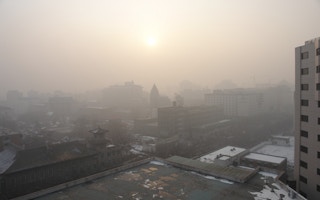Air pollution takes years off people’s lives. It causes substantial pain and suffering, among adults and children alike. And it damages food production, at a time when we need to feed more people than ever. This is not just an economic issue; it is a moral one.
To continue reading, subscribe to Eco‑Business.
There's something for everyone. We offer a range of subscription plans.
- Access our stories and receive our Insights Weekly newsletter with the free EB Member plan.
- Unlock unlimited access to our content and archive with EB Circle.
- Publish your content with EB Premium.
Air pollution can be produced both outdoors and indoors. For the poorest families, indoor smog from coal- or dung-fired cooking stoves is typically the more serious problem. As economies develop and start to electrify, motorize, and urbanize, outdoor air pollution becomes the bigger issue.
Cleaner technologies are available, with the potential to improve air quality considerably. But policymakers tend to focus myopically on the costs of action, rather than the costs of inaction.
With economic growth and rising energy demand set to fuel a steady rise in emissions of air pollutants and rapidly rising concentrations of particulate matter (PM) and ozone in the coming decades, this approach is untenable.
A new OECD report, The Economic Consequences of Outdoor Air Pollution, estimates that outdoor air pollution will cause 6-9 million premature deaths annually by 2060, compared to three million in 2010. That is equivalent to a person dying every 4-5 seconds.
Cumulatively, more than 200 million people will die prematurely in the next 45 years as a result of air pollution.
There will also be more pollution-related illness. New cases of bronchitis in children aged 6-12 are forecast to soar to 36 million per year by 2060, from 12 million today. For adults, we predict ten million new cases per year by 2060, up from 3.5 million today.
Children are also being increasingly affected by asthma. All of this will translate into more pollution-related hospital admissions, projected to rise to 11 million in 2060, from 3.6 million in 2010.
These health problems will be concentrated in densely populated areas with high PM concentrations, especially cities in China and India. In per capita terms, mortality is also set to reach high levels in Eastern Europe, the Caucasus region, and other parts of Asia, such as South Korea, where aging populations are highly vulnerable to air pollution.
The impact of air pollution is often discussed in dollar terms. By 2060, 3.75 billion working days per year could be lost due to the adverse health effects of dirty air – what economists call the “disutility of illness.”
The direct market impact of this pollution in terms of lower worker productivity, higher health spending, and lower crop yields, could exceed 1 per cent of GDP, or $2.6 trillion, annually by 2060.
Massive as they are, however, the dollar figures do not reflect the true costs of air pollution. Premature deaths from breathing in small particles and toxic gases, and the pain and suffering from respiratory and cardiovascular diseases, do not have a market price.
Nor does the experience of constantly inhaling foul-smelling air, or forcing your child to wear a face mask just to play outside. These burdens weigh far more heavily on people than any price tag can represent.
“
Premature deaths from breathing in small particles and toxic gases, and the pain and suffering from respiratory and cardiovascular diseases, do not have a market price.
Nonetheless, the truth remains that policymakers tend to respond more to hard figures than to abstract experiences. So the OECD examined myriad economic studies on air pollution to quantify what people’s health is worth to them.
On average, individuals would be prepared to pay around $30 to reduce their annual risk of dying prematurely by one in 100,000. Using well-established techniques, these “willingness-to-pay” figures were converted into an overall value of premature deaths caused by outdoor air pollution, as illustrated, for example, in the OECD’s Mortality Risk Valuation in Environment, Health and Transport Policies.
By that measure, the global cost of premature deaths caused by outdoor air pollution would reach a staggering $18-25 trillion a year by 2060. Arguably, this is not “real” money, as the costs are not related to any market transactions. But it does reflect the value people put on their very real lives – and the value they would put on policies that would help to delay their very real deaths.
It is time for governments to stop fussing about the costs of efforts to limit air pollution and start worrying about the much larger costs of allowing it to continue unchecked. Their citizens’ lives are in their hands.
Simon Upton is Director for the Environment, OECD.
Copyright: Project Syndicate, 2016.
www.project-syndicate.org











